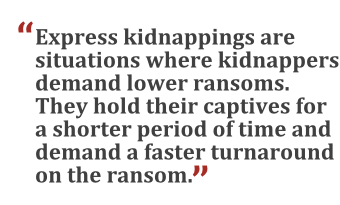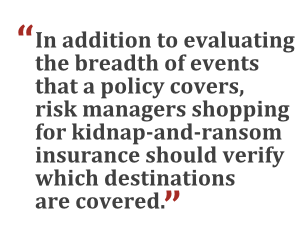 Picture this: You're on a business trip and just finisheda long day of work. It's late evening, and you're walking to arestaurant near your hotel, when two men approach you asking fordirections. As you begin to answer, they flash a gun and push youinto a car that has just pulled up to the curb. They drive you toan ATM, where they force you to empty your account and call yourfamily to deposit more money in the account. You're held for a day,and the kidnappers receive $8,000.
Picture this: You're on a business trip and just finisheda long day of work. It's late evening, and you're walking to arestaurant near your hotel, when two men approach you asking fordirections. As you begin to answer, they flash a gun and push youinto a car that has just pulled up to the curb. They drive you toan ATM, where they force you to empty your account and call yourfamily to deposit more money in the account. You're held for a day,and the kidnappers receive $8,000.
This increasingly common scenario is a portrait of an “expresskidnapping.”
|What is kidnapping? Essentially, the term refers to theabduction of a person who is held against his or her will. Eachyear, at least 15,000 to 20,000 kidnappings occur across the globe.That's the number of reported cases, but the real figure is likelyhigher. Because only 10 percent to 30 percent of all kidnappingsare reported to the media or authorities, it is difficult topinpoint an exact number.
|Kidnap-for-ransom, a situation in which a person demands a sumof money for the release of an abducted person, is quickly becominga multibillion-dollar industry. Drug cartels, terrorists, and otherorganized crime groups use kidnapping as a means of quickfundraising. The model has proven to be effective, especiallyin areas where local authorities may be less organized or morelikely to turn a blind eye.
|In 2012, the average demand for ransom was $2 million, and ithas been estimated that between $500 million and $1 billion isactually paid each year in ransom.
|Today, the top countries for kidnapping for ransom areMexico, Haiti, Brazil, the Philippines, India, Colombia, andVenezuela. Historically, people thought of South America and Mexicowhen the subject of kidnappings came up. And until recently,kidnapping incidents were largely concentrated in that region.However, between 2004 and 2014 the area dropped from accounting for55 percent of the world's kidnapping incidents toaccounting for only 23 percent. During the same time, kidnappingsin Africa and Asia Pacific grew from 18 percent to 50 percent ofthe world's total.
|Unfortunately, this geographic shift does not signal an overalldecrease in the number of incidents. Globally, kidnappingsincreased during the decade that ended in 2014.
|A Significant Risk for InternationalTravelers
One of the biggest risks associated with international traveltoday is the risk of kidnapping. Many people incorrectly believeonly wealthy or high-profile individuals are at risk, but that isnot the case. In fact, there has been a distinct shift in thekidnapping business model over the last decade. Today kidnapperstend to target upper-middle and middle class individuals in whathave been called “express kidnappings.”
| Expresskidnappings are situations where kidnappers demand lowerransoms—almost always below $100,000, and often below$10,000. They hold their captives for a shorter period of timeand demand a faster turnaround on the ransom. Thesekidnappings are rarely reported to the authorities, and theyusually do not draw the attention of the media. Because expresskidnappings attract less attention, kidnappers tend to performthese crimes in higher volume.
Expresskidnappings are situations where kidnappers demand lowerransoms—almost always below $100,000, and often below$10,000. They hold their captives for a shorter period of timeand demand a faster turnaround on the ransom. Thesekidnappings are rarely reported to the authorities, and theyusually do not draw the attention of the media. Because expresskidnappings attract less attention, kidnappers tend to performthese crimes in higher volume.
Kidnapping is a crucial topic for anyone traveling outside thecountry—and especially for business travelers. One of the best waysthat business travelers can protect themselves from a potentialkidnap situation is to avoid standing out as a tourist. Forinstance, travelers should dress in local fashion and avoid flashy,name-brand apparel, accessories, or equipment. They should alsorefrain from renting luxury cars or wearing expensive-lookingjewelry, whether or not it is real.
|Another way some travelers are choosing to protect themselves isthrough kidnap-and-ransom travel insurance.
|What Is Kidnap-and-Ransom Insurance?
Kidnap-and-ransom insurance policies typically protect travelersagainst a variety of insured events that may occur while traveling,possibly including kidnapping, ransom, extortion, wrongfuldetention, and hijacking. They are designed to do more than justprotect the insured victim financially. Most such policies providea package of benefits and services to help the insured deal withthe event, recover money spent, and handle situations and expensesthat result from the crisis event.
|Losses typically reimbursed by kidnap-and-ransom insuranceinclude the following:
 Ransom—moneypaid in a kidnap-for-ransom situation. Most policies do notdirectly pay ransoms on behalf of the insured, but they willreimburse the insured when a loss has been incurred. Basically, thefamily of the kidnapped victim supplies the ransom money, thusincurring the loss, then seeks reimbursement from the insurer underthe kidnap-and-ransom policy.
Ransom—moneypaid in a kidnap-for-ransom situation. Most policies do notdirectly pay ransoms on behalf of the insured, but they willreimburse the insured when a loss has been incurred. Basically, thefamily of the kidnapped victim supplies the ransom money, thusincurring the loss, then seeks reimbursement from the insurer underthe kidnap-and-ransom policy.- Transit/delivery loss—a loss due todestruction, disappearance, confiscation, or wrongful appropriationof ransom while it is being delivered to the person who demandedit.
- Accidental death ordismemberment—compensation related to an individual'sdeath or permanent physical damage related to a kidnapping.
- Legal expenses—for a group plancovering multiple people, such as employees at a company, the legalexpenses provision covers a claim or suit brought by a coveredemployee against the company for breaching legal obligations whichmay have caused an insured event. The benefit covers the cost ofdefending the claim and any damages awarded. While less common,this benefit could also provide coverage for a similar scenario iffamily members were covered on a family plan.
- Additional expenses—medical andpsychiatric care, salary replacement, travel accommodations,interest on loans to raise money, and other costs related to akidnapping incident.
Clearly, financial support of victims is a key element ofkidnap-and-ransom insurance; however, these policies are not justabout the money.
|Some policies also provide victims and/or their representativeswith access to a multilingual team specifically trained to handlecrisis situations. These consultants provide advice on how best torespond to an incident, and they work with local law enforcementwhen appropriate to help ensure safe resolution of the event. Theyhave specialized training that is invaluable in successfullyhandling the varied and difficult components of a kidnap-for-ransomscenario.
|Businesses Can Benefit from Kidnap-and-RansomInsurance
Because business travelers often travel alone and are typicallyunfamiliar with their surroundings, companies are under increasingpressure to protect their employees from kidnappings abroad. Thewebsite of the U.S. State Department provides good informationabout regions with high rates of kidnapping and other concerns.
|Kidnap-and-ransom policies differ slightly from company tocompany, but it is important for a business to find a policy thatis right for its employees. For instance, make sure akidnap-and-ransom policy includes coverage for other types ofcrisis incidents that could affect traveling employees—incidentssuch as threats, extortion, disappearance, and detention.
|In addition to evaluating the breadth ofevents that a policy covers, risk managers shopping forkidnap-and-ransom insurance should verify which destinations arecovered. Many plans restrict coverage in more dangerous regions orrequire a rate increase for those areas. Make sure there iscoverage in place for all locations that you expect employees tovisit over the duration of the policy.
|Corporate risk managers shopping for this coverage should alsoverify the experience level of the security team that will handlenegotiations should an incident occur. Many carriers have anagreement with a specific firm. Take some time to research thatfirm to learn about the experience level of its securityconsultants, and about how successful they have been in handlingnegotiations, ransom delivery, evacuations, and other key types ofincidents covered by the plan.
|!["While there is no way to completely eliminate the risk [of] a kidnapping or other crisis incident, travelers should understand the risks for the locations they are visiting and prepare ahead of time."](http://media.treasuryandrisk.com/treasuryandrisk/article/2016/12/07/krampen-kidnap-ransom-insurance-pq3.png) Finally,review wording to ensure that the policy offers leniency to itssecurity consultants in deciding whether to advise local lawenforcement if an incident occurs. In some locations, local lawenforcement is well-equipped with the necessary tools and trainingto effect a favorable outcome for these difficult situations. Butin other areas around the world, knowledge and effective tools maybe lacking. There have even been situations where local lawenforcement was involved in varying levels of participation withthe criminal activity. It's important for kidnapping-and-ransominsurance policies to include verbiage that requires the insurer toconsider the victim's safety before notifying authorities.
Finally,review wording to ensure that the policy offers leniency to itssecurity consultants in deciding whether to advise local lawenforcement if an incident occurs. In some locations, local lawenforcement is well-equipped with the necessary tools and trainingto effect a favorable outcome for these difficult situations. Butin other areas around the world, knowledge and effective tools maybe lacking. There have even been situations where local lawenforcement was involved in varying levels of participation withthe criminal activity. It's important for kidnapping-and-ransominsurance policies to include verbiage that requires the insurer toconsider the victim's safety before notifying authorities.
In addition to purchasing insurance coverage, businesses lookingto protect employees who travel abroad should consider providingtraining. Employees should know not to tell anyone that they arecovered by a kidnap-and-ransom policy; this information could makethem a target for kidnappers. Likewise, they should not take theirkidnap-and-ransom ID card with them. Instead, they should leave itat home, with a trusted family member or friend.
|Before traveling, employees should also store pertinent contactnumbers in their phone and know the name of the response team thatwould be involved if a situation were to occur.
|While there is no way to completely eliminate the risk that akidnapping or other crisis incident might occur, travelers shouldunderstand the risks for the location they are visiting and prepareahead of time by purchasing a kidnap-and-ransom plan. In short,kidnap-and-ransom insurance puts more support in your court shouldyou ever need to battle the bad guys abroad.
|—————————————
| Jim Krampen is the co-founder of SevenCorners, Inc., a U.S.-based provider of various types of businessand consumer travel insurance. With more than 25 years ofexperience in the insurance industry, Krampen has extensiveknowledge and expertise in the areas of benefit design,underwriting, and distribution of insurance programs. He hasdirected the development of Seven Corners' program managementservices by effectively partnering with insurance carriers andcustomers to design and implement customized retail insuranceprograms for various markets.
Jim Krampen is the co-founder of SevenCorners, Inc., a U.S.-based provider of various types of businessand consumer travel insurance. With more than 25 years ofexperience in the insurance industry, Krampen has extensiveknowledge and expertise in the areas of benefit design,underwriting, and distribution of insurance programs. He hasdirected the development of Seven Corners' program managementservices by effectively partnering with insurance carriers andcustomers to design and implement customized retail insuranceprograms for various markets.
Complete your profile to continue reading and get FREE access to Treasury & Risk, part of your ALM digital membership.
Your access to unlimited Treasury & Risk content isn’t changing.
Once you are an ALM digital member, you’ll receive:
- Critical Treasury & Risk information including in-depth analysis of treasury and finance best practices, case studies with corporate innovators, informative newsletters, educational webcasts and videos, and resources from industry leaders.
- Exclusive discounts on ALM and Treasury & Risk events.
- Access to other award-winning ALM websites including PropertyCasualty360.com and Law.com.
*May exclude premium content
Already have an account? Sign In
© 2024 ALM Global, LLC, All Rights Reserved. Request academic re-use from www.copyright.com. All other uses, submit a request to [email protected]. For more information visit Asset & Logo Licensing.







